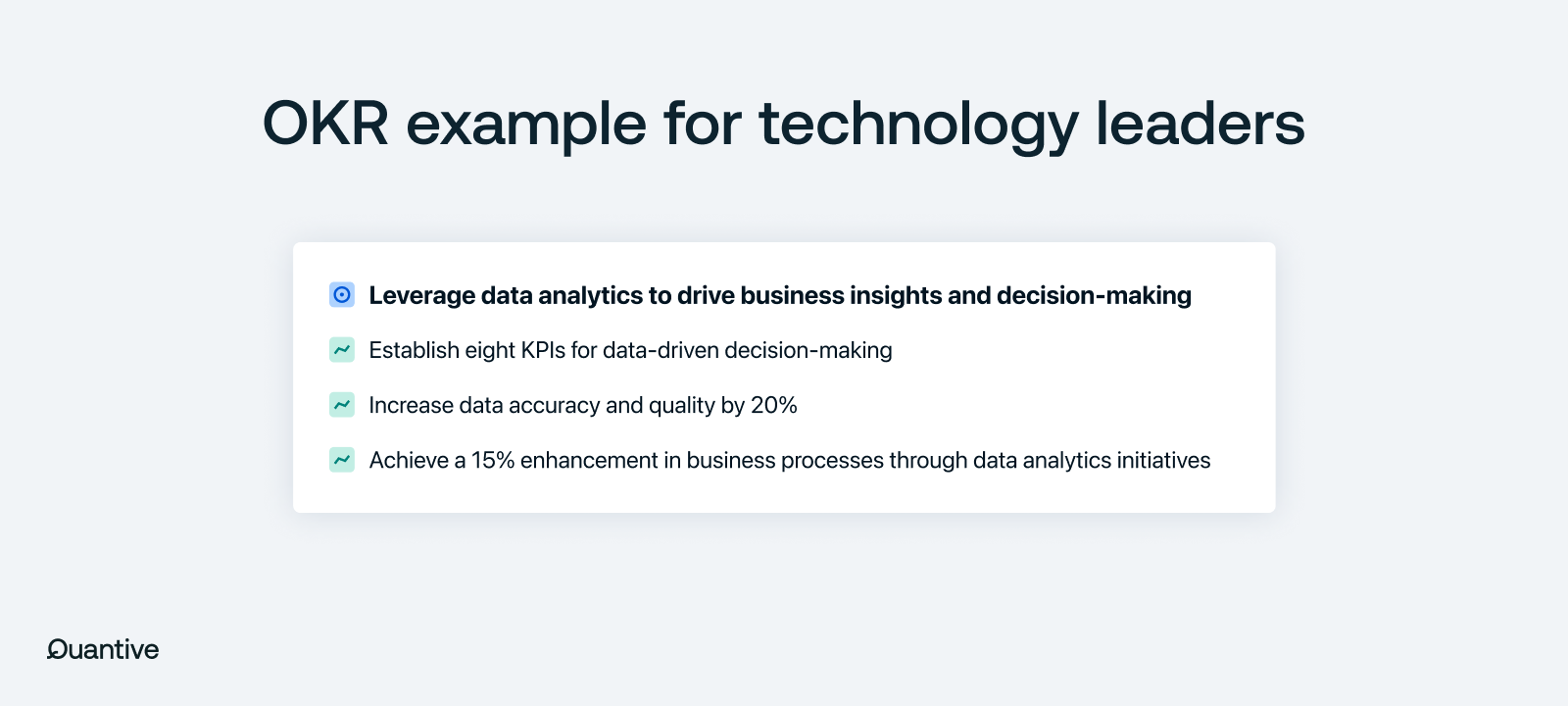Quantive is now part of WorkBoard. Get to know WorkBoard:
As the digital and economic landscapes evolve and change, Chief Information Officers (CIOs) and technology leaders are more critical to a company's success than ever. In fact, 77% of CIOs say their role has been elevated given the current economic affairs.
As a CIO or technology leader, you are pivotal in connecting different parts of the organization. You bridge the gap between day-to-day operations and emerging, often disruptive, technologies — steering innovation, managing data surges, and facilitating integrations for agility, adaptability, and growth.
But this is no easy task. The increasing demands of your role call for a comprehensive approach to supporting, adopting, and integrating new technologies.
This is where the Modern Operating Model, objectives and key results (OKRs), and OKR software can give you an edge.
The Modern Operating Model empowers organizations to overcome challenges and achieve success by aligning priorities with objectives, promoting transparency, and fostering an outcome-focused culture. With OKRs and OKR software, organizations can set ambitious goals, enhance alignment, and drive continuous improvement for ongoing innovation.
In this article, we’ll discuss the transformative potential of OKRs and OKR software for CIOs and technology leaders like yourself. To help you see how they work in practice, we’ll go beyond theory using real-life case studies and OKR examples.
Main challenges of CIOs and technology leaders
As a seasoned leader, you’ve undoubtedly faced your fair share of unexpected challenges. Yet, three distinct challenges tend to disrupt the flow of your daily operations. These include:
- Ensuring a continuous focus on digital transformation
- Balancing priorities and managing the technical roadmap
- Staying ahead of technological changes
1. Ensuring a continuous focus on digital transformation
In today’s fast-paced digital era, organizations that neglect digital transformation risk fading into irrelevance. Falling behind can lead to snowballing negative outcomes: failing to meet customer expectations and produce customer satisfaction, losing market share, and dealing with operational inefficiencies and outdated systems that no longer meet market needs.
Therefore, a steadfast commitment to digital transformation is essential for growth, competitiveness, and long-term sustainability. The importance of this is reflected in current business priorities — a recent survey reveals that since 2020, digital transformation has taken the lead as the top priority for IT initiatives among global companies.
While resource constraints and ongoing uncertainty make focusing on digital transformation difficult, three main culprits make emphasizing digital transformation particularly challenging. These include:
- A lack of clarity and the fast pace of innovation
- Inadequate change management practices
- Poor cross-functional alignment
A lack of clarity and the fast pace of innovation
Emerging digital technologies and digital tools disrupt existing norms every few months, creating uncertainty and a lack of proven direction. Without a unified strategic vision of what needs to be done and when, teams may pull in different directions, resulting in inefficiencies and conflicting priorities. This calls for an actionable and strategic goal-setting approach that can help you navigate shifting market environments within existing processes.
Inadequate change management practices
Poor change management practices hinder progress in digital transformation initiatives. This translates to employee resistance to change, making it difficult to gain the support, buy-in, and skillset to sustain an ongoing, long-term focus on digital transformation. To overcome this, you must foster a change-embracing that actively engages employees, equipping them with the necessary training, resources, and tools for effective adaptation.
Poor cross-functional alignment
When teams lack alignment, collaboration becomes weak, and the implementation of digital initiatives becomes disjointed. Inconsistent adoption of digital transformation practices across functions and departments diminishes the organization’s ability to leverage its potential in the digital realm. Fostering cross-functional alignment requires a unified approach to strategy execution, ensuring cohesive work and alignment across functions.
2. Balancing priorities and managing technical roadmap
Balancing priorities and managing the technical roadmap can feel like walking a tightrope. As competing demands fight for attention, discernment becomes crucial in determining which projects and initiatives are more critical.
The key lies in finding the balance between addressing immediate needs and monitoring future technological advancements. This requires a visionary mindset that can accurately identify the technologies with the most significant potential, while ensuring the roadmap adapts to shifting business needs.
These factors often compound the challenge of balancing priorities and managing the technical roadmap:
- Poor interdepartmental collaboration
- A lack of accountability
- Dynamic business needs
Poor interdepartmental collaboration
When interdepartmental communication and collaboration are weak, objectives, goals, and tasks can fall out of sync, leading to employee conflicts. This creates a chaotic environment where conflicting priorities, duplicated efforts, and wasted resources become the norm. Critical information, like emerging challenges and opportunities, may also slip through the cracks, making it even harder to stay on track. The solution involves collaborative tools, shared metrics, and a culture of transparency.
A lack of accountability
Without clear ownership of objectives and goals, effective project execution is an uphill battle — projects struggle to gain momentum. Tracking progress and measuring results becomes unclear, impacting decision-making while increasing the likelihood of delays, oversights, and incomplete tasks. To drive accountability, you must assign ownership of goals and projects to designated individuals, ensuring responsibility for project progress.
Dynamic business needs
Navigating evolving priorities and technical requirements in a fluctuating business landscape can be demanding. Staying ahead requires a flexible and adaptive approach to address dynamic challenges and undertake emerging opportunities effectively. To keep your business on track, you must continually reassess and reprioritize initiatives — these must align with internal and external needs while leveraging available resources.
3. Staying ahead of technological changes
Keeping up with technological advancements is an ongoing process of resource allocation, knowledge acquisition, and staying connected with industry experts. Part of being a technology leader involves investing in your learning, engaging with thought leaders, and keeping the pulse on emerging trends.
“Industries are evolving at lightning speed, forcing organizations to hasten the pace of innovation. Therefore, it’s strategic to set priorities on an ongoing basis to improve performance and drive growth.”
– Elie Casamitjana, OKRmentors
Technology leaders must grow comfortable navigating the complex landscape of evaluating, integrating, and managing new technologies, considering factors like stability, security, and compatibility. These ensure a seamless fit with existing systems.
Three factors typically make staying ahead of technological changes especially difficult:
- Limited agility
- Rapidly evolving data-and-insight needs
- Siloed data, heterogeneous tech stack, and limitations in system compatibility
Limited agility
Swiftly responding to emerging trends and market shifts can become a substantial hurdle without organizational agility. Identifying, evaluating, and implementing new technologies slows down, causing delays in adaptability. To overcome this, you must embrace organizational agility, where teams adapt to business and market demands during decision-making.
Rapidly evolving data-and-insight needs
Ever-changing data-and-insight needs require improving digital data capture, analysis, and utilization. As data is increasingly abundant and complex, staying current on the best data management practices is also crucial. This can involve leveraging data analytics and AI technology for real-time processing and actionable insights, empowering informed decision-making based on the latest trends.
Siloed data, heterogeneous tech stack, and limitations in system compatibility
Siloed data, incompatible technologies, and restricted system compatibility hinder efficient communication and collaboration across departments and systems. This impacts your ability to leverage data-driven insights, resulting in fragmented data landscapes, redundant processes, and difficulties implementing technologies. To address this, prioritize data integration, streamline your technology infrastructure, and optimize technology implementation and management for seamless compatibility and collaboration.
“The pace of change is so quick, the winners are going to be the ones that can understand that and adapt the most quickly. It’s not always comfortable but now more than ever IT needs to be comfortable being uncomfortable.”
– Michael Carlin, VP Business Technology Solutions & CIO, AbbVie
The need for an all-encompassing framework
The challenges of continuously focusing on digital transformation, balancing priorities and managing the technical roadmap, and staying ahead of technological changes require a comprehensive, self-sustaining operational framework.
This framework should assist you in overcoming your issues as a technology leader by providing the following capabilities:
- Agility and flexibility: Promoting adaptability and empowering effective change management to enable you to respond to internal and external business dynamics
- Focus and accountability: Keeping top-level objectives at the forefront of everyone’s mind, translating them into individual or team goals, metrics, and outcomes to foster active engagement
- Alignment and collaboration: Cultivating a unified front with shared goals and a common understanding of tasks and progress, ensuring that individuals and teams work toward a collective vision
- Data management and system compatibility: Providing the tools and infrastructure to harness your business data as a strategic asset, with well-organized data management practices and a tech stack that streamlines change
“Technology has been transforming companies for decades, but where in the past it may have been a change to a department or a division, it is now important enough to change their entire business model. It was a subset of industries, but now it is most industries.”
– Brad Strock, CIO, Paypal
The Modern Operating Model
One such comprehensive framework is the Modern Operating Model, operationalized by OKRs. This model embraces principles and practices designed to tackle the challenges brought on by our rapidly changing world, demanding a cultural shift within your organization.
At its core, the Modern Operating Model is built upon the following beliefs:
- Team priorities must connect to top-line objectives
- Decision-making should be decentralized
- Organizations should be transparent and trustworthy
- Business should be outcome-focused
- Teams should be fast and agile
- Feedback loops should be compressed
This holistic framework comprises five components:
- Define the destination: Establish a shared mission, vision, values, and strategy to foster cohesion, trust, resilience, and focus
- Change the business: Transform your business by setting ambitious OKRs that align teams, boost engagement, enable measurable progress, and drive strategy execution
- Run the business: Utilize OKRs and KPIs to track progress and facilitate data-driven decision-making
- Do the work: Foster a culture of accountability, collaboration, communication, continuous learning, and feedback, where employees are rewarded based on merits and values
- Assess and adapt: Leverage business monitoring to gather and analyze data, enabling you to assess performance, adapt strategy, address challenges, and drive efficiency

OKRs: The framework executing the Modern Operating Model
Let’s dive deeper into the engine of the Modern Operating Model: OKRs. As a goal-setting methodology, OKRs offer quantitative data through key results and confidence assessments, and quantitative insights through reviews and retrospectives. As such, allowing your organizations to reap benefits such as:
- Creating ambitious goals that inspire greatness
- Driving vertical and horizontal alignment
- Boosting efficiency and engagement by focusing on what matters
- Cultivating a work culture that values outcomes
- Facilitating continuous improvement
- Fostering knowledge through valuable insights and foresight
Read more benefits of using OKRs for your business

Solving critical challenges with OKRs and OKR software
Given these benefits, OKRs are a powerful solution for juggling priorities, navigating the technical roadmap, staying on top of emerging tech trends, and driving digital transformation.
“The OKR revolution is here, and it’s global. From tiny startups to huge enterprises across borders and business sectors, the OKR method has taken root.”
— The Global State of OKRs Report
However, implementing OKRs using static, outdated tools like spreadsheets, Word documents, or PowerPoint presentations isn’t ideal. These lack the dynamic capabilities, real-time tracking, scalability, collaboration functionalities, and data-driven insights to make OKR implementation effective and sustainable. In fact, a recent report acknowledged the use of OKR software as a best practice that distinguishes top-performing organizations experienced in OKRs from their less-experienced peers with lower strategic performance.
In this section, we’ll explore how OKRs, alongside OKR software, can help you overcome your main challenges by nurturing the following capabilities:
- Agility and flexibility
- Focus and accountability
- Alignment and collaboration
- Data management and system compatibility
Agility and flexibility
The OKR framework empowers you to set clear and measurable goals that seamlessly adapt to the ever-changing business landscape. It promotes continuous improvement through feedback loops, helping you stay ahead in technology by strengthening your agility. Additionally, OKRs embed effective change management practices into your daily operations, ensuring your organization can meet dynamic needs and keep up with the fast pace of innovation.
“62% of OKR overachievers evaluate themselves as excellent in their ability to be agile and adapt — 62 times higher than OKR beginners.”
– The Global State of OKRs Report
To maximize your agility and flexibility, you need specific capabilities found in OKR software. Designed to handle large volumes of dynamic data and interdependencies, OKR software takes the hassle out of tasks like updating data, tracking progress, and reporting. Not only will you save precious time by automating these tasks, but you’ll also ensure current data is at your fingertips. Having access to this real-time progress on strategic goals means faster data-driven decisions, shorter time to market, and increased speed of innovation.
Another advantage of OKR software is its role as a centralized platform for managing OKRs. Capabilities like shared OKRs, key result updates, OKR status, and confidence in achievement ratings ensure transparency and communication on changes can be done seamlessly. The quicker you inform everyone about adjustments, the easier it is for teams to identify risks, adapt, and realign their efforts to ensure everyone’s working toward the updated objectives.
Case study: Deutsche Telekom Services Europe (DTSE)
By fostering transparency and connecting everyday work to strategic goals, Quantive Results enabled DTSE to adapt to remote work and improve collaboration. The software’s configurability and flexibility allowed teams to tailor the tool to their unique needs, encouraging a shared vision while allowing teams to set individual goals. With the help of Insightboards, managers and team leads gained valuable real-time insights, enabling swift reactions, collaborative discussions, and synergy across departments. As a result, Quantive Results drove DTSE’s digital transformation, positioning them as a leading digital telco while empowering them to be more responsive.
Focus and accountability
OKRs are a great way to boost focus and accountability within your tech teams and organization. By spotlighting key priorities, OKRs bring transparency to progress and eliminate confusion during ongoing market changes. They provide a clear strategic direction for your organization, ensuring that everyone takes ownership of their OKRs. This collective responsibility keeps the entire team productive, working towards both adaptable short-term goals influenced by market dynamics, and long-term goals driven by the company’s mission, vision, and values.
Regular check-ins and progress tracking are integral to the OKR methodology, and core capabilities of OKR software. Ongoing updates foster a culture of accountability with their built-in system for update reminders, monitoring goal progress, and evaluating team performance. Using key results’ measurability, OKRs hold individuals and teams responsible for their goals, creating a strong sense of ownership and commitment.
Case study: BaseKit
Quantive Results transformed BaseKit’s organizational dynamics, bringing goal clarity and alignment to the forefront. With Quantive Results, employees gained a deep understanding of the company’s objectives and their unique roles in driving success. The OKR software emphasized BaseKit’s organizational goals, making them easily accessible. As a result, the company saw greater employee engagement, a shared sense of direction, and a vibrant culture characterized by collaboration and innovation.
Alignment and collaboration
OKRs take a metricized approach, uniting everyone in pursuit of shared goals. They help connect individual, team, and department objectives with your vision as a tech leader. As per the Global State of OKRs report, 54% of leaders with more than three years of OKR experience ranked themselves as excellent or above average in their ability to align teams.
By employing a cascading structure, OKRs transparently break down high-level goals into team-level objectives, ensuring synchronization of efforts and acknowledgment of dependencies. This fuels cross-functional collaboration through a shared approach to adaptive strategic execution. Teams with complementary skills can leverage shared or cascading OKRs to rally together toward common objectives, leading to synergistic outcomes that propel the business forward.
OKR software — a one-stop shop for creating, managing, and tracking joint OKRs — can streamline alignment. It allows you to create, manage, and track shared and cascading OKRs, visually showcasing how these trickle down the organization.
You can also use OKR software to boost collaboration with capabilities like virtual strategy planning whiteboards, commenting, flexible OKR ownership, and the ability to link OKR dependencies. Your stakeholders will have a collaborative space to strategize, share ideas, celebrate victories, and discuss progress.
Case study: SPAR
Before SPAR implemented Quantive Results, they struggled to effectively communicate goals and track outcomes due to their reliance on an outdated paper-based system. However, after discovering the power of OKRs, they found the perfect solution in Quantive Results. Thanks to its user-friendly and intuitive design, they could effortlessly introduce and encourage their employees to use the platform. The asynchronous functionality of Quantive Results proved particularly useful during the pandemic, enabling the distributed Central Office Logistics team to maintain consistency and efficiency in managing their OKRs. As a result, SPAR experienced improved goal achievement, team alignment, and ongoing collaboration through regular updates, check-ins, and comprehensive goal overviews.
Data management and system compatibility
Implementing the OKR framework has many advantages regarding managing data and system compatibility. With data-driven OKRs, you shift decision-making from subjective opinions to measurable key result data, simplifying data requirements while enabling data-backed choices.
OKRs promote a standardized approach to data management by using the same data types for setting and tracking goals across the organization. This practice streamlines communication, reduces data complexities, and eliminates the need to juggle multiple data sources to track goals.
Moreover, the simplicity of OKR data — combined with the framework’s continuous improvement culture — makes it easy to adapt to evolving data-and-insight needs. As data requirements change, you can effortlessly adjust OKRs to align with new insights and emerging trends. This ensures your competitiveness in a fast-paced business environment.
To achieve effective system compatibility and streamline OKR data, OKR software is a must. Features like OKR progress reports and performance dashboards provide tailored, actionable insights on OKRs and KPIs. You can also link standard data systems to your OKR software to automate updates and consolidate data. This can help you create a holistic overview of your OKR progress. Additionally, managing your OKRs in dedicated software means you can easily retrieve data from past and present initiatives, further supporting strategic planning, data observation, and digital transformation initiatives.
Case study: Spotahome
As Spotahome experienced rapid growth, they faced the challenge of deriving meaningful insights from their complex and disparate data sources. This hindered their ability to make informed decisions and unite teams under a shared objective. After realizing the usefulness of OKRs, Spotahome sought a solution to harmonize their business systems, automate OKR updates, and streamline operations. Using Quantive’s OKR software, Spotahome successfully integrated its systems and consolidated its data into one centralized hub. This marked a transformative shift in their data management capabilities, reliably connecting data integration with effective goal management.
“Quantive is the only product out there that links OKRs and business intelligence. After seeing what Quantive is capable of, this product is a key asset for any company with a data-driven mindset.”
– Bryan McEire, CTO, Spotahome
Get a better understanding of OKR software capabilities here

5 OKR examples for technology leaders
Digital transformation
- Objective: Accelerate digital transformation
- Key result 1: Increase the overall digital maturity score by 20%
- Key result 2: Establish cross-functional digital transformation teams for 80% of strategic projects
- Key result 3: Reduce IT infrastructure costs by 15% through cloud migration and automation initiatives
- Key result 4: Increase employee participation in digital skills training and development programs by 25%
Data analytics and business intelligence
- Objective: Leverage data analytics to drive business insights and decision-making
- Key result 1: Establish eight KPIs for data-driven decision-making
- Key result 2: Increase data accuracy and quality by 20%
- Key result 3: Achieve a 15% enhancement in business processes through data analytics initiatives
Technical roadmap management
- Objective: Optimize technical roadmap management for strategic alignment
- Key result 1: Review technical roadmap to align with at least 90% of identified business goals
- Key result 2: Attain a minimum stakeholder satisfaction score of eight out of ten based on feedback surveys, focusing on transparency and usefulness of the shared technical roadmap
- Key result 3: Maintain an average adjustment time of two weeks or less for the technical roadmap based on changing business needs and market dynamics
- Key result 4: Incorporate at least 80% of stakeholder feedback and recommendations into the technical roadmap within two weeks of receiving them
System compatibility
- Objective: Achieve seamless system compatibility
- Key result 1: Increase the percentage of systems and applications with seamless integration by 15%
- Key result 2: Reduce data integration errors by 25% through improved data exchange protocols and practices
- Key result 3: Implement standardized compatibility frameworks and guidelines for 70% of systems to ensure consistency across communications
Organizational agility
- Objective: Foster agile transformation and adaptability
- Key result 1: Decrease the average time to reach critical decisions by 30%
- Key result 2: Cultivate a culture of innovation and experimentation by implementing and validating five new ideas or prototypes
- Key result 3: Conduct retrospectives or continuous improvement sessions for 90% of completed projects within four weeks of project implementation

Kickstart your digital transformation journey with OKRs
As a leader responsible for navigating fluctuating external demands, you need a reliable solution to ensure agility and focus within your organization. The Modern Operating Model, powered by OKRs, offers precisely what you need to meet your digital transformation objectives.
By embracing the power of OKRs and OKR software using Quantive Results, you can continuously focus on digital transformation, effectively manage your technical roadmap, and proactively adapt to technological advancements. This powerful combination fosters alignment, agility, focus, and accountability, trailblazing your organization’s innovative capabilities.
Why Quantive
With all your must-have OKR software capabilities at its core, Quantive Results goes the extra mile to support your OKR journey. With AI-powered Platform Intelligence, Quantive Results offers valuable insights and assistance at every step — from creating OKRs to seamless onboarding and insightful retrospectives. Its unique Check-ins feature adds a qualitative approach to OKR updates, enabling teams to share progress on strategic objectives weekly. This integrates OKRs into daily work, aligning short-term tasks with long-term company-wide objectives. Quantive’s OKR software also offers 160+ pre-built integrations with everyday tools, alongside customizable Executive Dashboards that ensure easy access to vital information.
Eager to supercharge your OKR experience? Unleash the full potential of your team’s performance with Quantive Results.
Quantive empowers modern organizations to turn their ambitions into reality through strategic agility. It's where strategy, teams, and data come together to drive effective decision-making, streamline execution, and maximize performance.
As your company navigates today’s competitive landscape, you need an Always-On Strategy to continuously bridge the gap between current and desired business outcomes. Quantive brings together the technology, expertise, and passion to transform your strategy and playbooks from a static formulation to a feedback-driven engine for growth.
Whether you’re a fast-growing scale-up, a mid-market business looking to conquer, or a large enterprise looking for innovation, Quantive keeps you ahead – every step of the way. For more information, visit www.quantive.com.





